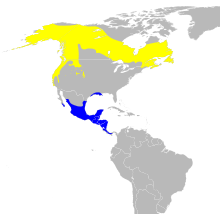Wilson's warbler
| Wilson's warbler | |
|---|---|

| |
| Adult male | |
| Scientific classification | |
| Domain: | Eukaryota |
| Kingdom: | Animalia |
| Phylum: | Chordata |
| Class: | Aves |
| Order: | Passeriformes |
| Family: | Parulidae |
| Genus: | Cardellina |
| Species: | C. pusilla
|
| Binomial name | |
| Cardellina pusilla (Wilson, A, 1811)
| |

| |
| Range of C. pusilla Breeding range Wintering range
| |
| Synonyms | |
|
Muscicapa pusilla ( protonym )Wilsonia pusilla Myiodioctes pusillus | |
Wilson's warbler (Cardellina pusilla) is a small New World warbler. It is greenish above and yellow below, with rounded wings and a long, slim tail. The male has a black crown patch; depending on the subspecies, that mark is reduced or absent in the female. It breeds across Canada and south through the western United States, and winters from Mexico south through much of Central America. It is a very rare vagrant to western Europe.
Taxonomy
Wilson's warbler was
There are three recognized subspecies:[7]
- C. p. pusilla was described by Alexander Wilson in 1811.[8]
- C. p. pileolata was described by German naturalist Peter Simon Pallas in 1811.[8]
- C. p. chryseola was described by Robert Ridgway in 1902.[8]
The chryseola subspecies, which nests in northern coastal California to southwestern coastal Canada, has a distinctive orange-tinged yellow forehead. The population of the subspecies has declined sharply in the 21st century because it migrates preferentially to the southern end of the Baja Peninsula in Mexico,[9] where luxury resort and residential developments have replaced the bird's habitat.[10]
Description

Wilson's warbler is a small
Wilson's warbler resembles the yellow warbler: the latter is readily distinguished by its different shape, yellow wing markings, and yellow tail spots.[13]
Distribution and habitat
The breeding habitat is fairly open woodland with undergrowth or shrubs and thickets in moist areas with streams, ponds, bogs, and wet clearings.[12]
Wilson's warbler breeds in northern Canada and the western US; it winters in overgrown clearings and coffee plantations,
Behavior and ecology
Breeding
Nesting generally begins in early March in west coast populations, and extends into August in the northern range.
Feeding
Wilson's warbler is an insectivore, feeding primarily on insects gleaned from leaves and twigs, or caught by flycatching.[14] Some of these insects include beetles, bees, or caterpillars. Wilson's warbler is an active forager, moving rapidly through shrubs, on the ground, and sometimes in taller trees during the winter.[12] Feeding birds often twitch their tails or flick their wings nervously.[15] The observed feeding rate of the male Wilson's warbler was not significantly different between males with or without mates.[16] It also eats a few berries.[11]
References
- . Retrieved 12 November 2021.
- ^ Wilson, Alexander (1811). American Ornithology; or, the Natural History of the Birds of the United States: Illustrated with Plates Engraved and Colored from Original drawings taken from Nature. Vol. 3. Philadelphia: Bradford and Inskeep. p. 103, Plate 26 fig. 4.
- ^ Paynter, Raymond A. Jr, ed. (1968). Check-List of Birds of the World. Vol. 14. Cambridge, Massachusetts: Museum of Comparative Zoology. pp. 50–51.
- ^ Barrows, Walter Bradford (1912). Michigan Bird Life. East Lansing: Michigan Agricultural College. p. 685.
- S2CID 13691956.
- ISBN 978-1-4081-2501-4.
- Rasmussen, Pamela, eds. (2020). "New World warblers, mitrospingid tanagers". IOC World Bird List Version 10.2. International Ornithologists' Union. Retrieved 9 October 2020.
- ^ a b c "ITIS Report: Wilsonia". Integrated Taxonomic Information System. Retrieved 21 May 2010.
- S2CID 16556818.
- ^ Graham, Rex (2013). "Ornithologists discover why Wilson's Warbler subspecies vanishing". birdsnews.com.
- ^ a b c d e "All About Birds: Wilson's Warbler Life History". Cornell Laboratory of Ornithology. Retrieved 4 December 2009.
- ^ a b c d e f g h i "Wilson's Warbler "Wilsonia pusilla"". Boreal Songbird Initiative. 25 February 2014. Retrieved 25 April 2019.
- ISBN 978-0-9696134-0-4. Retrieved 23 November 2011.
- ISBN 0-7136-3932-6.
- ISBN 1-55591-535-3
- ^ Gowaty, P.A. (1996). Field studies of parental care in birds: New data focus questions on variation among females. Advance in the Study of Behavior, 25. 477-531.
External links
- Xeno-canto: audio recordings of Wilson's warbler
- "Wilson's warbler media". Internet Bird Collection.
- Wilson's warbler photo gallery at VIREO (Drexel University)
- Wilson's warbler Species Account – Cornell Lab of Ornithology
- Wilson's warbler - Wilsonia pusilla - USGS Patuxent Bird Identification InfoCenter

